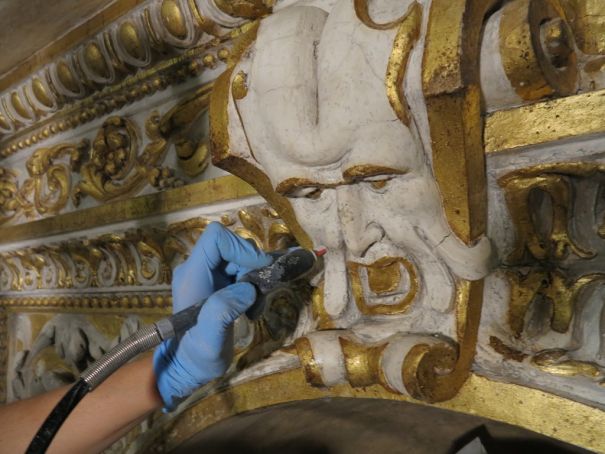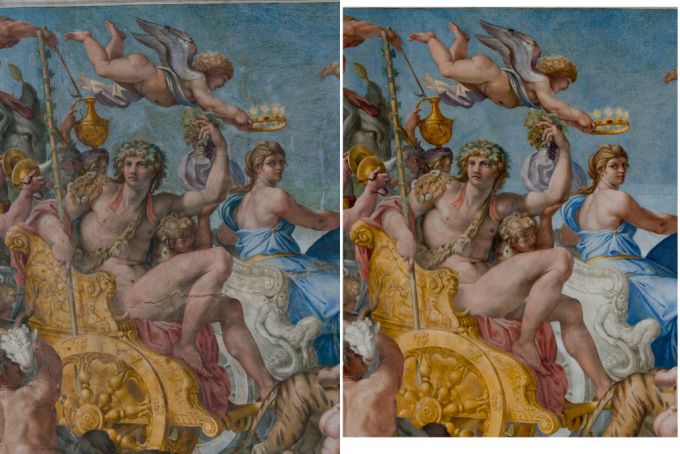Restoration of Galleria Carracci at Palazzo Farnese reveals hidden drawings, dates and signatures.
“And like a horse he hauls his trolley the whole day through, working till he’s almost tired unto death.” So the early Baroque painter and art historian Giovanni Baglione describes Annibale Caracci’s ten-year stint (or call it more a frenzy) on behalf of Cardinal Oduardo Farnese. The preliminary sketches alone for the so-called Galleria Carracci number 600, most of them now in the Louvre or in British private collections. True, Annibale was assisted by his brother Agostino, until a row separated them, and later by cousin Ludovico. Yet in scale and spectacle the galleria is up there with Michelangelo’s Sistine Chapel ceiling and Raphael’s Stanze, quantity with quality written all over it. Indeed it is beside the latter painter that Carracci was buried, an inscription equating him (or almost) with the artist who most inspired him: “...equal in genius and fame, but unequal in fortune.”
And there’s the rub. Cardinal Odoardo with all that wealth should have been the perfect patron. The Farnese pope Paul III had spread the roots of nepotism wide and deep to benefit the family for generations – at least till the line ran out as the last male heirs, evidently suffering from obesity, failed to reproduce. The end came with the death of Elisabetta Farnese in 1766.
At the height of the family’s wealth, Annibale Carracci received “just 10 scudi a month, plus free bread and wine,” laments Baglione's biography. Taking scudi as forerunner of the euro, that doesn’t sound much, albeit in silver. Worse, payment was often delayed. After 10 years a bowl arrived via a Farnese middle-man. When Carracci lifted the lid, only another 500 scudi were inside. Hardly generous. The disappointed artist took to drink. Or, as the cardinal saw it, “excessive melancholy”. By 1609 the painter was dead, aged 49. One can divine his feelings from a late self-portrait now in the Hermitage in St Petersburg. A picture within a picture, there he hangs, nailed to a lonely easel, shadows deepening behind him.
It’s a far cry from the Farnese ceiling, its marvels now enhanced thanks to 18 months of loving restoration financed mainly by the World Monuments Fund. And yes – love, love, love is the vaunting theme, a sort of erotic A to Z – Andromeda to Zeus. The emotions on view vary from violent to idyllic, desperate to triumphant, the only type not on view being the Christian agape.

Diana puts Endymion into a perpetual sleep so as to enjoy the sight of him forever. Two cupids turn accomplices, one with a finger to his lips to ensure the famous toyboy does not awake. Equally questionable are various abductions – at opposite ends of the same sky/ceiling – Ganymede by Zeus (or more precisely his willing eagle) and Hyacinth by Apollo. In Apollo’s case, though, there are mitigating circumstances: the god had killed the youth by mistake with a discus, subsequently turning him into first a flower then a constellation. Worse is the rape of Europa by Zeus disguised as a bull, from which cross-species immortal-mortal union would spring the Minotaur.
Meanwhile on the upper ceiling hurtles Mercury to hand Paris the apple of discord which, to change metaphor, will spark the Trojan war. Mercury, instead of his wand, bears a trumpet, maybe sounding alarms for the 10-year bloodshed ahead. Or maybe it echoes the satyr blowing a trumpet in the peaceful wedding march alongside: another joy of the ceiling is its multitude of possible meanings.
Demonstrating the power of a gift offered, a matching picture shows Pan holding up some linen now washed whiter than white to the normally chaste Diana, her downward trajectory paralleling that of Mercury two pictures away. In another painting a putto sniggers as burly Hercules resorts to cross-dressing and holds a girly tambourine, Iota commandeers his lion-skin and club. It’s enough to make the famous Farnese Hercules eat his plinth! The power of seduction is also there: in an attempt to distract Jupiter from arbitrating in the Trojan war, Juno stands naked before husband but for a magic girdle given her by Venus.
Venus, as one might expect, is omni-present. In one painting Anchises undoes Venus's strappy sandals prior to an encounter that will result in the birth of Aeneas, Virgil's hero, and the founding of the Latin race, as the inscription on the footstool – GENUS UNDE LATINUM – makes clear. Venus is there again in Agostino’s Trionfo marino, though some experts give her another name, seeing here rather Glaucus and Scilla. No such identity problems with poor Polyphemus. Fool for love, at one end of the ceiling he waxes musical, his massive dangling legs a tribute to Michelangelo’s prophet Jonah over the entrance to the Sistine Chapel. On the opposite wall the one-eyed Cyclops resorts to type, brutally hurling a boulder at his better-favoured rival Aci, making off with Galatea.
More happily, the pièce de resistance is the massive love triumphant – Bacchus and Ariadne representing the newly-weds Rannuccio Farnese (Oduardo's brother) and Margherita Aldobrini, niece of the then Pope Clement VIII. Omnia vincit amor, to cite one of the medallions. Notice how the elephant stops short, the massive rest of him pressing forward unseen, presumably with other celebrants. So Carracci, master of the margins as well as of the centre-piece, leaves us to imagine the rest of the procession beyond the newly-restored trompe-l'œil gold frame. Bacchus’s chariot appears fresh-burnished too; ditto the dizzyingly raised amphora, then the cupid-held coronet crowning Ariadne. Threatening to steal the show is Silenus in his cups, not quite falling off his donkey, a figure that Pietro da Cortona would take up again in his famous ceiling in Palazzo Barberini.

Yet to dwell on individual paintings is perhaps misguided. The work is a unicum, a tribute both to Michelangelo and to the ancient statuary of which the Farnese amassed the best collection ever, including the Farnese Hercules now in Naples’ Archaeological Museum.
Here in Palazzo Farnese was where the Baroque – or at least a branch of it – took off. Not in shadow or chiaroscuro, but in a blazing colour. (See side notes on restoration.) That said, Annibale (of whom Caravaggio, arriving in Rome about the same time, was a great admirer) could manage shadow as well: The Eurydice medallion, for instance. In the larger paintings, the shadows have also benefited, as have, more obviously, the colours: 18 months of sponging with special Japanese paper now reveal how the Carraccis used a pointillist technique 400 years before its time.
One can only wonder how much contemporary art will last so well. The famous shark of umpteen times better-remunerated Damien Hirst is already beginning to decompose in its formaldehyde. Poor Carracci and his measly 500 scudi! Yet his work shines on, thanks to the restorers, as brilliant in every sense as when it was painted.
SIDE NOTES
The Carracci Gallery at Palazzo Farnese, home of the French embassy to Italy, reopened its doors to visitors in late September following a €1 million restoration that began in March 2014.
The work on the 17th-century baroque masterpiece, which took 18 months, was a joint Italian-French venture and was funded with a grant of €800,000 from the World Monuments Fund, while the Italian culture ministry provided €200,000 for preliminary restoration studies.
The process involved the restoration of the frescoes and stucco of mythological scenes which were completed primarily by the Bolognese maestro Annibale Carracci between 1597 and 1607. Carracci was assisted in this task by his brother Agostino and several of their up-and-coming protégés such as Domenichino and Giovanni Lanfranco.
In addition to returning the stucco and fresco colours to their original splendour, the cleaning revealed design modifications as well as important clues as to which artists were responsible for various sections.
Restorers also uncovered drawings, graffiti, signatures and dates from the 18th century, including work by the celebrated Rococo painter and caricature artist Pier Leone Ghezzi.
Construction of the palace began in 1517 after a design by architect Antonio da Sangallo the younger. On the death of Sangallo in 1546, Michelangelo took over the project, modifying Sangallo’s designs. When Michelangelo died in 1564, Giacomo della Porta oversaw work on the building until its completion in 1589.
Visitors to Palazzo Farnese must book in advance, for details see website.
By Martin Bennett





















